Do you make rational decisions or are you a slave to primitive thinking?
Does free will exist? Do you buy a product because you analyzed the options and decide it’s the logical choice? Or are you impulsively (and subconsciously) making decisions based on the part of your brain that’s well over 70,000 years old?
As it turns out, we use our old, reptilian brains to make most of our decisions. Yet, we continue to optimize for rational, logical buyers.
Table of contents
What Is the Reptilian Brain?
Bart Schutz, consumer psychologist, had this to say about the reptilian brain…

Bart Schutz, Online Dialogue:
“There are two systems in the brain. The first one is system two. It’s you, which makes it very interesting because system two is aware of itself. It is consciousness, self-awareness. If I think about myself (“I’m Bart”) and you think about yourself, that’s system two at work. We’re consciously reflecting.
The other system is not conscious. The totally optimized one is not aware of itself, we’re not aware of [it]. We think that we, system two, are the ones who are controlling our behavior, our emotions, our decisions and we forget the other part. I want you to start optimizing for both of these parts. And if I have to choose, choose the other one.” (via CTA Conference)
So, system one…
- Is intuitive and associative
- Is quite fast
- Is always on
- Has a large capacity
- Requires no effort
And system two…
- Is rational and logical
- Is extremely slow
- Is very lazy
- Is easily depleted
- Requires full focus
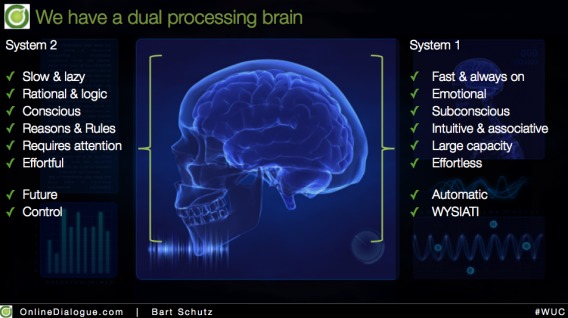
As a result, it’s difficult to make a truly rational decision.
System one is also known as our reptilian brain.
Why Is It Important?
So, your reptilian brain makes the irrational decisions. Since rational decisions are so difficult to make, your reptilian brain is very important.
If your product is not the rationally best choice, you must appeal to the reptilian brain (system one). If you appeal to system two, it will analyze the facts and determine that you’re not the best choice. (There can only be one most rational choice. So, while we don’t like to admit it, our products often aren’t the most rational choice.)
If your product is the rationally best choice, you should still appeal to the reptilian brain. System two may determine that it’s the most rational choice, but what if your visitor has done a lot of critical thinking and depleted their system two? System one will be the decision-maker, so you should still optimize for it.
What Are the Pillars of Reptilian Brain Behavior?
There are five core factors that drive the reptilian brain: pain, fear, emotion, ego, and contrast. If you can find ways to use these factors, you’ll be able to appeal to system one.
1. Pain
Remember that the reptilian brain is primitive. It’s not concerned with gaining pleasure (e.g. getting to wear a new dress for less money), it’s concerned with avoiding pain (e.g. not having to spend hundreds on a dress you’ll wear once for work).
Take Rent frock Repeat, a designer dress rental service, for example.

If I were going to rent a dress for a formal event, my two pain points might be: I don’t like / have time for dress shopping and finding a dress that fits / flatters is difficult for just about everyone.
Note that Rent frock Repeat addresses the fit pain directly on their site, providing four different remedies for the pain.
2. Fear
The reptilian brain is concerned with its own survival. As a result, it can be skeptical and fearful of change and the unexpected.
Consider Amazon’s scarcity / urgency play here…

“Waitlist full”, “Ends in: 41:16”, “Ends in 1:06:16”. Note that “Missed” availability is pre-selected to create fear. Now, our reptilian brains might not be fearing something as serious as being eaten by a lion, but they are fearing missing out.
These tactics signal the reptilian brain, which asks “I need a pressure cooker, right?” and decides “We need to act now or we’ll miss it forever.”
3. Emotion

Bart Schutz, Online Dialogue:
“You are never, ever only dependent on rationality. Pure rationality does not exist. We call it Descartes error and what that means is that if we only have a rational argument without any emotion attached to it, we would not be able to give weight to the arguments. We would just keep on making pros and cons, but they would have no value. So, you need the emotional charge to the rational argument.” (via CTA Conference)
The reptilian brain operates on emotion instead of logical and rationality. Therefore, when you’re appealing to emotion, you’re appealing to the reptilian brain.
One of the easiest ways to appeal to emotion is to trigger the pain. Why? Because we often forget about our pain points unless we’re in a specific context. For example, you might hate the invoicing system at work, but when you’re at home surfing the web, you’re not thinking about that.
Here’s another example from Talia Wolf of GetUplift.co, who focuses on emotional persuasion…

This landing page is void of emotion. “Get Matched and Date” is very functional, the testimonial praises the site itself. Talia launched this variant as a test…

“Find Your Perfect Match” plus a happy couple on a beach. If you’re single (and why else would you be on a dating site?), this subtly reminds you that you don’t have your perfect match yet.
That’s fear. “Why haven’t I found my perfect match? Everyone else has a perfect match. Am I falling behind? I should find my match right away.”
So, the fear is created by reminding you of the pain point, whether you realize it existed or not, and then the fear is eased by the solution. “These two look so happy, this must work.”
The result of the test? A 24% increase in signups and a 48% increase in paying customers.
Earlier this year, I wrote an in-depth article on emotional persuasion. If you’re interested in this topic or just want to learn more about appealing to the reptilian brain, take 8-10 minutes to read it. (Note: This guide also includes positive emotions, which the reptilian brain is less driven by.)
4. Ego
Due to its survivalist mentality, the reptilian brain is incredibly self-centred. How will this affect me? What’s in it for me?
As a result, it’s best to use word like “you” and “your”. The reptilian brain doesn’t need to think about those two questions, they’re already being answered. Whenever you can, write copy directly to your visitors and put anything you claim into perspective (visually, if possible).
Take Uber, for example…

Notice the use of “your”. Notice the smile / smirk signalling contentment and power. If this headline read “Taxis, On demand” or “Private Cars, On Demand”, it wouldn’t be nearly as effective. If the woman’s facial features were different, it wouldn’t be nearly as effective.
Copy Hackers does something similar…

“Find Your Copywriter”, “Who’s the perfect copywriter for your next project?”, “List your services”, “Boost your business”.
Whenever you make an effort to insert your visitor into the hypothetical situation, you’re appealing to ego. Environmental ads that show animals behind bars, drunk driving ads that show you driving with impaired vision, etc.
5. Contrast
Have you ever wondered why before and after photos work so well? Or why the Pepsi vs. Coke, Mac vs. PC, McDonalds vs. Burger Kind, Playstation vs. Xbox rivalries are so compelling? It’s because the reptilian brain loves to contrast.
Take KISSmetrics, for example…
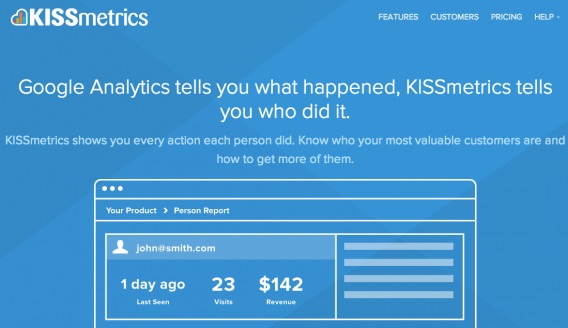
“Google Analytics tells you what happens, KISSmetrics tells you who did it.” used to be one of their more common headlines. Why did it work? Because it contrasts.
First of all, Google Analytics is well known, so it sets expectations. If I work in marketing, I now already know KISSmetrics is an analytics suite. Second, it shows the difference between the two.
Take a look at how Jenny Craig does it visually (and more directly)…

Note the before (the pain) and after (the remedy) photos.
How Can You Optimize for the Reptilian Brain?
Do some pillars have more of an impact than others? When asked what the top three things to consider when marketing to the reptilian brain were, Roger Dooley had this to say…

Roger Dooley, Neuroscience Marketing:
“1. Find your customer’s pain points. In today’s society, pain probably doesn’t involve carnivorous predators, but those pain points still exist. A buyer may emphasize price, for example, but it could be that the true pain point is running out of product and shutting down production.
2. Use contrast. Don’t just describe the benefits of your product, describe the contrast between using it and using an inferior product or note at all. If possible, do this visually to increase the impact.
3. Use emotion. The more raw emotion you can pack into your marketing, the better. Logical arguments don’t persuade the reptilian brain, but simple emotional appeals will work. If possible, as suggested in the previous item, use visuals that the brain can process easily.”
Based on the pillars, here are some other ideas for optimizing for the reptilian brain.
1. Deplete System Two
System two and system one are a team. They work together. You should optimize for both, but, as Bart said, if you have to choose, choose system one. And if you don’t have the rationally superior product or service, choose system one.
In order to do that, you’ll need to ensure (a) that system two is depleted and resting and (b) that system two doesn’t reappear after it’s rested.
The easiest way to deplete system two is to provide options and force decisions. Take a look at this example…
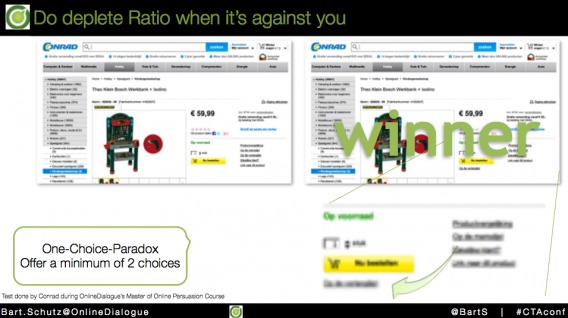
According to Bart, adding the option to add an item to a wishlist increased conversions, despite the fact that almost no one actually added items to their wishlist.
Here’s another example…
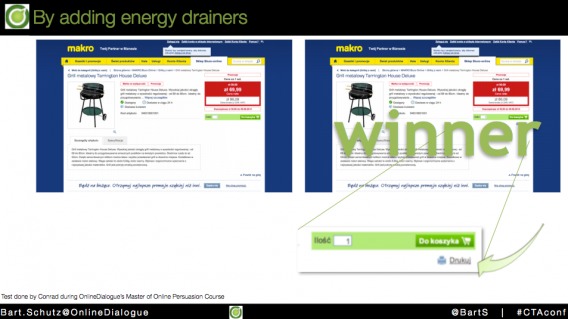
A print button. A print button increased conversions. Why? Because system two thrives on rational decisions. Those decisions, of course, deplete system two’s energy, causing it to default to system one, the reptilian brain. That’s exactly what you want.
2. Show Proof
You know that the reptilian brain is skeptical. It only makes sense, then, that you need to provide proof that your product or service will remedy the pain. However, since the reptilian brain isn’t logical, how you prove that will be a little different than you’re used to…
- Use the science of familiarity to your advantage. If you can relate your product or service to something the reptilian brain is already familiar with, you’re one step closer.
- Increase cognitive fluency. The easier something is to think about, the more likely we are to think about it. In other words, position and present your product or service as simply and directly as possible.
- Use social proof. Remember that only system two has the capacity to look to the future. The reptilian brain is stuck in the present. Social proof that focuses on how your product or service improved someone’s present / future will go a long way.
- Use visuals. Show the before and after pictures, give a demo, provide a product video, show screenshots, etc.
Heidi Haskell has written extensively on the topic. Here are her suggestions…

Heidi Haskell, SurveyGizmo & MarketerGizmo:
“What you can do: Use simple and short sentences if you need to use words. Focus on imagery that demonstrates the value you are proposing in a way that feels real, concrete, and/or familiar.
Assume that your consumer will be skeptical in your claims, and that you need to prove it to them by providing evidence. Help the consumer to visualize what you are trying to say and prove it to them.
Show the customer that there will be more value than cost. If you are communicating about your product in person or on camera to the consumer, use props wherever you can to help them visualize what you are saying.
Customer testimonials are a great source of proof. It shows the reptilian brain, which can only perceive the present, what has happened in the past. It is more likely to trust your claim of the future if you have proof of what has already happened.
Show a quick demonstration of your product. Help them to see how they could use your product to alleviate pain in some way or multiple ways.
Data can sometimes be helpful, though it’s important to make your data visual to immediately grab attention. The reptilian brain is not responsible for calculations and so you’ve got to show it what you are trying to say.” (via NeuroMarketing)
3. Focus on Points of Change
Being so skeptical, the reptilian brain does not enjoy or adjust to change well. When you think about it, it makes perfect sense. If something is different, you don’t know what to expect, which makes it more dangerous. For that reason, the reptilian brain tends to focus on the beginning and the end.
Here’s what you can do…
- Make your argument quickly and restate it at the end.
- Write scannable copy, especially if you have a long landing page. Otherwise, the reptilian brain will tune out the middle copy.
- Maintain consistency when it comes to your overall argument, but pepper your landing page or copy with indications that something new is coming (e.g. directional cues), otherwise the reptilian brain will tune out.
4. Use Images
Your reptilian brain is very visual because the optic nerve connects directly to that part of the brain. If you’re walking in the woods one day, your reptilian brain might see a wolf long before other areas of the brain have processed the idea of a wolf being in the woods.
It’s what protects us from predators and danger. It’s what you can use to market to the reptilian brain.
Here’s how…
- Ask yourself (and your visitors / customers via qualitative research) how your visualize life after your product or service. What imagery comes to mind? A marketing agency might say a fox with glasses. A content marketing tool might say a modern library.
- Simplify your visualization as much as possible. Never sacrifice clarity for the sake of being clever. Remember, the reptilian brain is automatic. So, if your visualization isn’t obviously connected to your product or service, it might get lost in translation.
- When you think you have the perfect visualization, ask a panel of people to tell you what they think of when you show them the visual.
- Place visuals near points of friction… tastefully. It’s a balance of helping your visitors visualize before they convert and protecting your call to action from distractions.
5. Identify Automated Responses & Use Them
Since the reptilian brain works automatically, you have automated responses. Take a look at this example from Bart…

Did you respond with Duey? I know that I did. Of course, the answer, logically, is George.
You’ve probably seen this one before…

Can you say the color of the word instead of reading the color that’s spelt? Perhaps, but it’s likely very difficult.
If everything seems normal and familiar and routine, the reptilian brain will make automatic choices (like “Duey” or reading blue when the color is red).
Here’s how you can use this to your advantage…
- Follow copy and design prototypes. What are visitors expecting when they land on an eCommerce site or a SaaS site or an agency site? Meet those expectations to keep the reptilian brain in control.
- Eliminate distractions and unexpected alerts, especially ones that require logical thought. Am I saying all opt-out popups and on-site surveys are evil? No, but I am saying that they wake up system two, which isn’t what you want if your product or service isn’t the most rational choice.
6. Simplify
Do you remember the board game Don’t Wake Daddy? You would move around the board, trying to complete the tasks without waking the sleeping dad. In this case, system two is the sleeping dad. The more you simplify your copy and design, the more likely you are to not wake system two.
Bart provided this surprising example…

Here’s how you can do it…
- Remove calls to action. In some cases, like the one above, it makes sense to remove calls to action. A call to action means a decision and a decision may wake system two, leading to rational thought. Removing the call to action means the reptilian brain can just move to the next step automatically without much thought.
- Make images bigger. If it’s not already apparent, images and visualization are incredibly important. They’re easier for the reptilian brain to process, so if you’re looking to simplify and reduce friction, reduce copy and increase image size.
Conclusion

Bart Schutz, Online Dialogue:
“There is a very stiff, stubborn thought in even my brain. This cannot be the case. I have a free will. I choose products. I buy products because I thought about it. The thing is that one of the big reasons for that is that I know I have reasons for why I bought the product. Everyone asks why I bought it and I go, […], ‘well, because’ and I go, ‘1-2-3’.
But nowadays, we’re testing 1-2-3 and they do bullshit. Zero. Those are not the reason why people buy it. We’re testing other things and those are uplifting, but we will not realize that.” (via CTA Conference)
The reptilian brain is behind many of your decisions (and your visitors’ decisions, too). Still, many of us neglect to optimize for it because, like Bart, we believe that we choose products rationally, that we buy because we’ve thought about them. [Tweet It!]
Here’s how you can optimize for it…
-
Deplete system two with choices.
-
Show proof that your product or service will remedy the pain via familiarity, increased cognitive fluency, testimonials and visuals.
-
Focus your efforts on points of change (i.e. the beginning and the end).
-
Use simple images that help visualize your remedy because the optic nerve connects directly to the reptilian brain.
-
Use copy and design prototypes and eliminate unexpected alerts that require a non-automatic decision.
-
Keep system two asleep by simplifying design and copy.
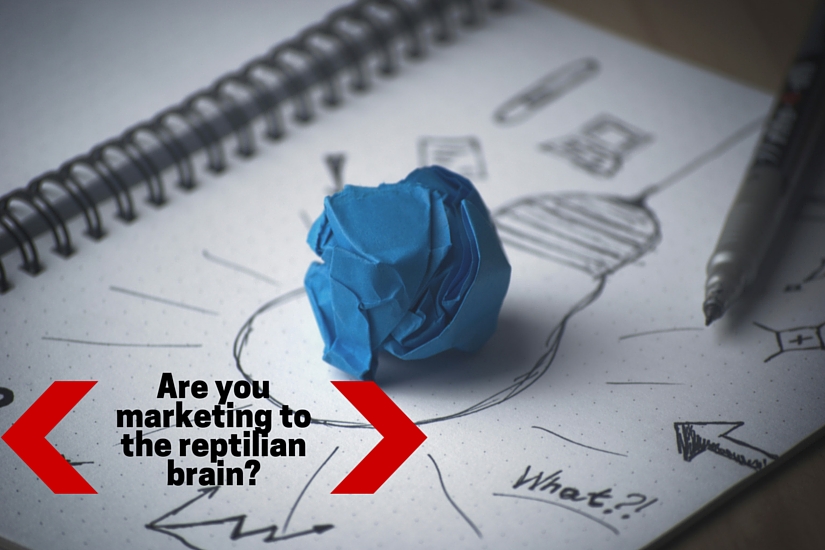
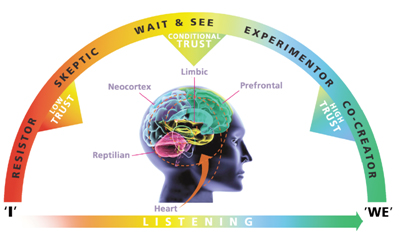



I was waiting for this post for years.
Thank you! 😃
Ah, thanks Saulo! Glad you liked it.
Excellent article with one minor correction: the colored words test, known as a Stroop test, is only hard when you name the color of the written word, not what the word says. That’s just the opposite of what you wrote.
https://en.wikipedia.org/wiki/Stroop_effect
Thanks for catching that, Ken! Glad you liked the article.
This is an advertising piece parading as an objective treatise on human behavior. While some of the content has been validated as true and useful, the entire thread of this “piece” is designed to get people to buy or buy into a product or school-of-thought. This kind of stuff is similar to Emotional Intelligence con, the Briggs-Meyers scam, any predictive personality test, and false dilemmas presented by the likes of Dan Ariely and those who are making millions peddling stuff they say is scientific that really only rises to the level of pseudo science.
First of all, thanks for reading, Rex.
I’m really interested in persuasion psychology, especially some of the concepts Bart Schutz covered in his CTA Conference presentation. So, I decided to look into the reptilian brain a bit further and share what I found.
Here’s the presentation, if you’re interested…
http://2015.calltoactionconf.com/bartschutz/
Anyway, to each his own! Thanks again.
Science doesn’t work in a “to each their own” set of rules…
As much as I love the fact that the brain is getting more attention in relation to the business I have been working in for nearly a decade… It really fuels my distress the way it is communicated.
Rhetorically talking about the reptilian brain the way you, and Bart does, implies that you can somehow “talk” to one part of the brain. Reptilian also implies that its somewhat more crude and old – which might be the case looking at evolution, but evolution has more to it than time – THAT part of the brain keeps evolving in conjunction with the other parts of our brain.
Proof of that is that we are seeing a lot of change in social behavior after only a decade with smartphones – facebook etc. Its changing the wiring of our brain.
The points made about fast, slow, contrast, automatic etc are all correct – but when you then try to drive that into a straight line with split tests – it is at a high risk of falling into the “confirmation bias” category.
Both systems are used, and system 2 has a lot more power than we give to it, SPECIALLY ONLINE – its the main reason for bounce rates and exit rates – because it primarily works as an inhibitor. It inhibits emotional reactions and “controls”
What i would like to have come across is that the notion of the “reptilian” brain as its put forward here – is wrong – we have a complete brain, and its much more complex than you are making it to be here.
Its so complex that we might not ever be able to fully understand it – even with the amazing progress of quantum computing.
Hey Karsten! Thanks for reading. I really enjoyed your “Why the Brain Matters in Your Business” article.
System one and system two work together, of course. I’m by no means saying we should ignore one or the other. I’m actually hoping to follow with an in-depth look at system two in the new year.
If you’re ever interested in writing a guest post, we’d love to hear from you on the topic of persuasion psychology (and how it’s evolving).
Sure Shanelle, I would love to.
Great. Just shot you an email.
Just to show some crisp scientific evidence for my previous statement – A new study released yesterday of 60 people, shows just how important the dorsomedial prefrontal cortex (PFC) is to decision making.
“The study shows that the dorsomedial PFC plays a critical role in mediating the balance between prior value assessment and an object’s immediate appeal”
Meaning – we might have an intuitive and instant reaction, coming from the bottom-up part of our cognitive control, however the top-down has executive power that outplays this. This is still subconscious – but has nothing to do with our so-called “reptilian brain”.
We are not as automatically driven as (a lot of) neuromarketing studies suggest, however the executive functions take a lot of energy, and is highly skewed towards the current thread of thought (our attention, and inner narrative) – so in some cases the subconscious bottom up stimuli “wins” – but I would like to stress that online browsing is very heavy on the top down cognitive control (albeit mostly subconscious still)
The back button – is still – a top down cognitive controlled action, so is clicking on the buy button, however the information fed to the executive control, is sifted through a lot of heuristics and thus understanding those can have a great impact on your success – but its not as simple as “talking to the reptilian brain” :)
-Just say’in :)
https://muhc.ca/newsroom/news/scientists-montreal-neuro-shed-light-little-studied-part-brain
Thanks for sharing that study, Karsten. Really looking forward to your article now.
I absolutely agree that it is not as simple as marketing to the reptilian brain all the time, always, forever. (Nothing is ever that simple in neuromarketing, hah.) However, I do think a lot of marketers forget about system one completely, choosing to exclusively appeal to rational logic.
This article was designed to show people how to optimize for system one so that it isn’t completely ignored, not to argue that it’s the only part of the brain that matters.
Again, I hope to write on system two early next year, which will more clearly show how the two work together. Plus your article? We should be painting a pretty clear picture.
Great round-up of the relevant insights! I used a lot of these to create Shopping Quizzes, specifically by simplifying large choice sets (like apparel) down to visual, binary options, which then boost the ego by reflecting back YOUR personal Top 3.
That’s awesome! Have you noticed a difference in conversions?
Thanks for the kind words, Jennie.
Thank you for another great post for my collection Shanelle! I’m a true fan of how our primitive brain is key when talking about Psychology and Marketing.
Happy to help, Fabiola! Thanks for reading. Really appreciated.
This was one of the most interesting and thought provoking post I have read in long time. Excellent article and contents.
Thanks so much, Shirish! Glad I could help.